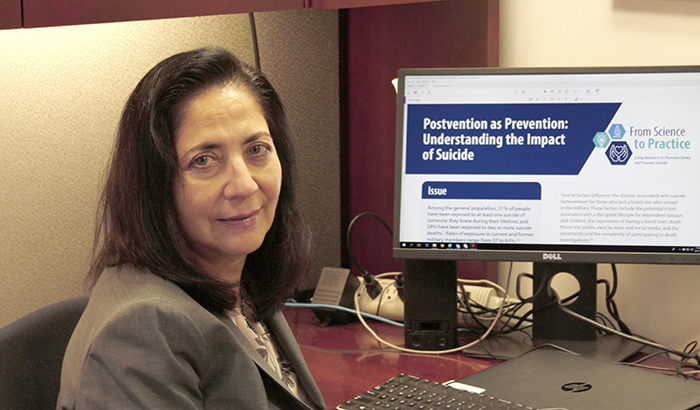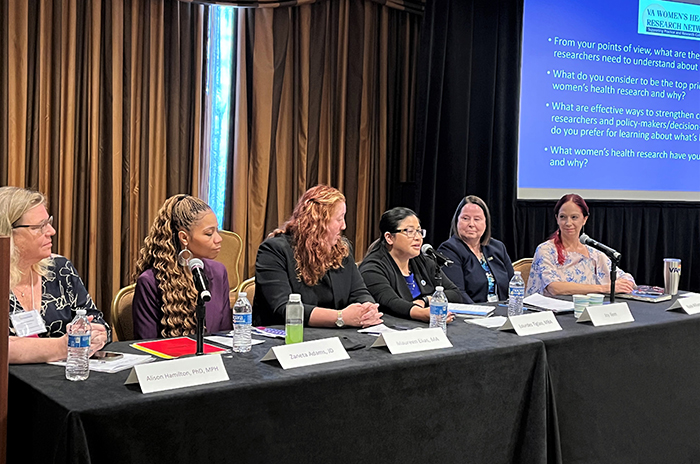Office of Research & Development |
 |


Dr. Gloria Workman, with the VA Office of Mental Health and Suicide Prevention, is leading an educational series that translates published research into informative tips for VA suicide prevention coordinators and mental health providers. (Photo by Mike Richman)
October 24, 2019
By Mike Richman
VA Research Communications
"We can't take our foot off the gas pedal in our efforts to prevent Veteran suicide."
Heidi Linn is a psychiatric nurse at the VA Eastern Colorado Health Care System. In her role, she’s on what she calls the “front lines” of caring for Veterans with suicidal thoughts.
She often turns to resources on suicide prevention to learn more about what she can do to help her patients.
One such resource is a new VA educational series called “From Science to Practice.” The program is run by VA’s Office of Mental Health and Suicide Prevention. It translates published research into informative tips that VA suicide prevention coordinators and providers can use to support their patients. The focus is on relaying suicide risk factors and preventive measures in a concise, easy-to-absorb way.

AI to Maximize Treatment for Veterans with Head and Neck Cancer

VA Researcher Named One of U.S.’ Top Female Scientists

2023 VA Women's Health Research Conference
VA suicide prevention experts are taking findings from peer-reviewed scientific journal articles and integrating them into documents on VA Pulse, an online information portal for VA employees, and on the website of the Office of Mental Health and Suicide Prevention.
The documents cover such suicide risk factors as depression, homelessness, isolation, unemployment, and trauma, as well as suicidal thoughts and behaviors. They include links to online sites that provide information, depending on the topic, on ways to help a Veteran who is at risk of taking his or her own life.
Linn is part of a large group of clinicians who have accessed the new series. “`From Science to Practice’ allows front-line workers and those vested in preventing suicide among Veterans to access the latest literature updates,” she says. “It also connects me, as a health care provider, to services within VA that will ultimately benefit our Veterans.”
Dr. Gloria Workman, a senior official in VA’s Office of Mental Health and Suicide Prevention, is leading the series. “We’re pulling out the major findings from scientifically grounded articles and making sense of them as a whole,” she says. “What do these documents tell us in terms of how the clinician can work with the patient? How can the clinicians put the findings into action in their clinical work? One of the agency’s goals when it comes to suicide prevention is putting research into action.”
One document, for instance, could include findings from at least 10 research papers that have the same theme. But the papers may explore various aspects of the topic and present different conclusions. Take postvention, for example. That concept is used in suicide prevention, in part, to help people heal from the grief of suicide loss and to prevent suicide among those who may be at high risk after a family member takes his or her own life.
“All of the papers will be on postvention, the same theme, but they may report different findings,” Workman says. “They’re not duplicative. They might be looking at different factors related to postvention, and thus the focus of the research is different in each study. One may be looking at the findings in terms of what family members can do, and maybe the others are looking at what a caretaker can do.”
Thus far, Workman and her staff have posted 14 documents, with a goal of completing 42 by next year. Those posted range in topic from the suicide risks associated with military sexual trauma to loneliness, opioid use, and unemployment. Each document includes four major sections—the issue at hand, key findings, implications, and ways everyone can help with links to VA and other government resources. The documents are limited to one page, front and back, to keep them as “short and sweet” as possible, as Workman put it.
Every document includes the following message: “There is no single cause of suicide. It is often the result of a complex interaction of risk and protective factors at the individual, interpersonal, community, and societal levels. To prevent Veteran suicide, we must maximize protective factors and minimize risk factors at all of these levels.”
Social isolation, substance abuse, and homelessness are the greatest risk factors that are affecting Veterans who have suicidal thoughts, Heidi Lynn says, noting that the three are interrelated.
In recent years, more than 1,500 papers have been published annually in peer-reviewed academic journals on suicide prevention, which is VA’s top clinical priority. The agency says an average of 17 Veterans are dying by suicide every day.
VA’s 2019 National Veteran Suicide Prevention Annual Report notes that in 2017—the most recent year for which data are available—the suicide rate for Veterans was 1.5 times the rate for non-Veterans, after adjusting for population differences in age and sex. In 2017, firearms were the method of suicide in 71% of male Veteran deaths and 43% of female Veteran deaths. Suicide is also one of the leading causes of death in the United States. In 2017, more than 45,000 American adults died by suicide, including some 6,000 Veterans.
Dr. Peter Gutierrez, a clinical research psychologist at VA Eastern Colorado, believes “From Science to Practice” is a good idea. He says there’s an “enormous gulf” between high-quality research and its impact on clinical practice.
“One reason for that is most clinical researchers are not experts in dissemination and implementation,” says Guitierrez, who is also co-director of the Military Suicide Research Consortium, a Department of Defense (DOD)-funded initiative that researches the causes and prevention of suicide. “As a result, they conduct their studies, present the findings at scientific meetings, publish papers in academic journals, and move on to the next study. The assumption is that clinicians read journals and are able to figure out how to apply what they read to caring for their patients. Those are large and, I would argue, erroneous assumptions.
“If VA has found a way for dissemination and implementation experts to monitor the scientific literature, translate promising research findings into practical recommendations for clinicians, and disseminate those recommendations to the front-line clinical staff who most need the information, that is a huge step in the right direction. It, of course, doesn’t solve the problem of whether or not having the information leads to changes in practice and improved patient outcomes. That requires additional research of a very specific type.”
Workman believes a program of this type—integrating findings from multiple research papers into a single document and providing guidance to clinicians on how they can help their patients—is unusual, in or outside VA. The Department of Defense produces the “Clinicians’ Corner Blog,” which summarizes research findings on mental health topics, including suicide. But that resource generally doesn’t include guidance on incorporating information into clinical practice.
She recently led a focus group, “From Science to Practice: Developing Communities of Practice at Your Local Facilities,” at a VA-DOD suicide prevention conference in Nashville, Tennessee. About 20 clinicians and other professionals in the field of suicide prevention attended the focus group, many of whom provided feedback on the program.
The Department of Defense, Workman explains, isn’t involved in developing the documents that are posted in the series. “However, we are exploring ways to expand our distribution of these suicide prevention scientific reviews to clinicians outside of VA to include DOD,” she says.
On a related topic, Workman and her colleagues are developing a companion series called “Together We Can,” which will provide practical information for Veterans, family members, and caregivers to support Veterans at risk of suicide. The topics selected will be similar to those covered in “From Science to Practice.”
“The `Together We Can’ series will be written in easy-to-understand language and will provide Veterans, family members, and caregivers links to resources they can use to help Veterans,” Workman says. “The links and the resources in the `From Science to Practice’ series are for clinician use. As such, the content is different, and the resources listed may vary.”
Users can access “Together We Can” documents on VA Pulse and on the website of the Office of Mental Health and Suicide Prevention. The series, like “From Science to Practice,” will be part of VA’s #BeThere campaign, which urges community leaders, friends, and family members to be there for Veterans and service members who may be at risk of suicide. The campaign coincides with Suicide Prevention Month in September. (Workman notes that an alternative venue besides Pulse is also in the works, to ensure easy access.)
Both online initiatives come as VA is implementing a comprehensive and coordinated approach to ending Veteran suicide.
"As such, VA has adopted the National Strategy for Preventing Veteran Suicide," Workman says. "It includes dozens of objectives to promote wellness, effective treatment, and recovery and provides a framework for identifying priorities, organizing efforts, and contributing to a national focus on Veteran suicide prevention. We can't take our foot off the gas pedal in our efforts to prevent Veteran suicide."
VA Research Currents archives || Sign up for VA Research updates